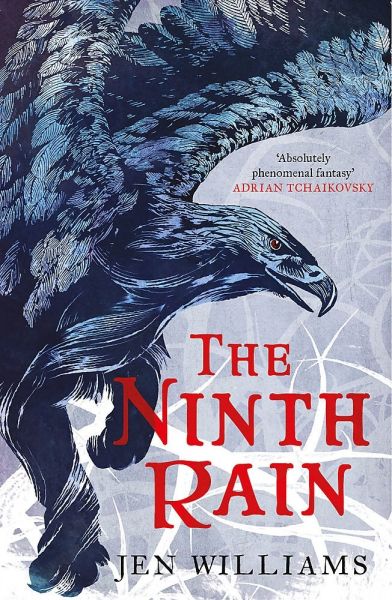Were It Not For Hope
The Ninth Rain (Winnowing Flame, volume 1)
By Jen Williams

6 Jan, 2020
2018’s The Ninth Rain is the first volume in Jen Williams’ Winnowing Flame trilogy.
Once the Eborans were rulers and guardians of their world; they were sustained and armed by their tree-god Ygseril. Eight times they fought the Jure’lia, invading horrors from beyond the sky. Eight times they won. In the aftermath of the eighth invasion, however, Ygseril died. Since then, the Eborans have suffered a long, inexorable decline.
Tormalin the Oathless abandons the remnant of once-great Ebora for a life of adventure and debauchery abroad, in the service of Lady Vincenza “Vintage” de Grazon. Vintage is determined to discover the true nature of the invaders and possibly a way to reverse the corruption each invasion leaves in its wake.
Vintage’s archaeology is surprisingly combat-intensive.
The Jure’lia come from nowhere in the known world. They arrive in great flying vessels the natives call Behemoths. Wrecked Behemoths litter the land. Their interiors could tell the natives something as to the nature of the invaders, but investigating the interiors is dangerous. Monstrous parasite spirits lurk near the wrecks, disintegrating any living being they touch.
Eborans aren’t in any sense human, having quite a lot tree-god about them. Nevertheless, they are mortal and incapable of dealing directly with the parasite spirits. It’s lucky that Tormalin took with him the family’s winnow-fire-forged sword Ninth Rain. It can hew spectral flesh, as Tormalin demonstrates on several occasions.
Enter another character, Fell-Noon. She can cast winnow-fire at will, provided she has a source of magical energy (aka other people’s life-force [1]) handy. Hotter than any mundane flame, Noon’s fire can incinerate spirits. Or it could if she weren’t held prisoner in the Winnowry. She’s a valuable resource, too useful to free.
Noon has been haunted by dreams of the Winnowry invaded by Jure’lia. Convinced her dreams are prophetic, she seizes on an opportunity to escape and flees the Winnowry.
The Winnowry didn’t get to be the fantasy equivalent of the Magdalene Laundries by letting their fell-witches escape. Noon tries to hide and fails. She is forced to take refuge with Vintage and Tormalin, who are powerful enough to protect her from the Winnowry.
Good news: the trio are on the verge of obtaining vital information about the Jure’lia. Bad news: they can’t stop the Ninth Jure’lia invasion.
~oOo~
Nota bene: there’s still more plot to come. You won’t get it all in the first book of the trilogy.
Many secondary fantasy worlds have one culture per race. Not true in this case: the Eborans do because they all come from the same big city, but the humans demonstrate the same range of cultures one would expect in a region as large as the one that features in the novel.
Yes, the Winnowry is run by fanatics and (possibly) led by an eldritch abomination. Yes, the Winnowers hunt down and enslave fell-witches. But they aren’t entirely incorrect. Fell-witches are dangerous. If the witches drain too much life-force, their donors will die. Once the witches are full of force, they’re a walking WMD. Would you want a bad-tempered witch living in your neighborhood?
(Well, the Winnowers couldtry the Professor X approach, wherein they try to convince witches they are part of society and should willingly help it. But there’s a lot less money in that than there is in theologically justified exploitation.)
We eventually learn that the Jure’lia are trying to Jure’lia-form Ebora. They are trying to transform Ebora into an environment that suits them, not the Eborans. I know that sounds evil, but is it really any worse than sweeping aside native North American species to make room for plants and animals we find useful and familiar? I admit that it is hard to put a positive spin on the Jure’lia practice of hollowing out Eboran heads to turn folks into drones or on the Jure’lia refusal to negotiate or communicate with beings they regard as food, but again, do we negotiate with cows?
I was a bit nervous when I started reading this book, since acquiring it was a bit of a chore and I might have had higher expectations than the actual novel justified. Happy news! Williams’ world has some interesting twists, the characters are sympathetic (well, the protagonists are), you cannot go wrong with combat-archaeology, and I was in the mood for a save-the-world plot. It’s true that this is very much Book One of a trilogy, which would normally annoy me, but I know the next two books will soon be in my hands.
The Ninth Rain is available here (Amazon UK)and here (Book Depository). It is not for sale in North America.
1: In this setting, magic costs. The Eborans used to take power from their tree-god, Ygseril. After their god was killed by the invaders, the Eborans experimented. Perhaps the blood from unwilling humans could be used as a power source? Um, no. Didn’t work, had terrible side-effects and oddly enough, humans turned out to be quite pissy about being eaten by their betters.
